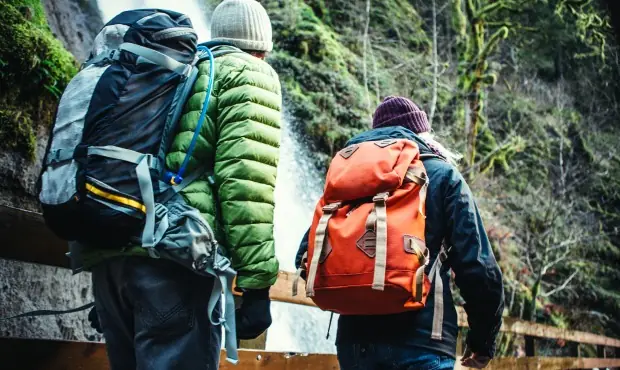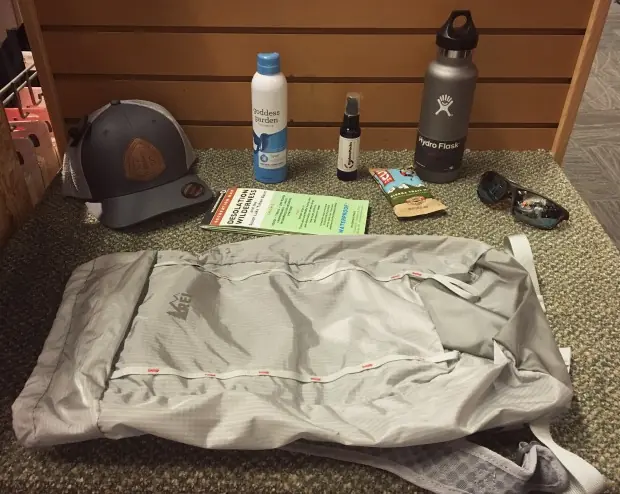
The great outdoors is full of surprises. While this uncertainty is part of what makes an outdoor adventure so thrilling, it can also make the outdoors a living hell if you're ill-prepared.
While it's always safe to err on the side of caution and bring a bit too much on a hike, the right packing list and the appropriate-size pack can save your back some undue stress.
Each of these packing lists builds upon the next, starting with the "eight essentials" for your basic short hike in mild conditions to a strenuous full-day hike in cool to colder conditions. These lists are full of all the gear you'll need to make your outdoor adventure safe and memorable.
Hike 1: A short hike (less than 2 hours) on a nice day.
Suggested hike: Devil's Garden Trail to Landscape Arch, Arches National Park (2-3 miles round trip). A great, easy hike best suited for early spring. Keep in mind that it is a popular trail, and it can get very hot in the summer.
There's nothing better than heading out on a beautiful Sunday morning on your favorite trail for a couple of hours.
For a shorter hike you might be able to get away with a simple waist pack and some water and food, but if you want to go hands-free, I recommend the REI Flash 18 pack. The Flash 18 is light enough to fold up into a tiny ball, but large enough to hold 18 gallons of anything you want. It's a solid pack that you can literally take around the world (I know from experience). Inside, I recommend putting these eight hiking essentials:

A) A 16-ounce water bottle: I like S'well bottles because they stay cold.
B) EnduroPacks electrolyte spray: A couple sprays of this sugar-free, portable concentrated electrolyte solution will help keep your fluid levels in check during any activity lasting more than an hour. Any other low-sugar fluid replacement like Nuun, Osmo, GU or Ultima will work as well.
C) 1-2 snack bars: If it's warm, it's best to bring bars that won't melt, so I recommend Kind Bars, Larabars or CLIF Mojo bars.
D) Cell Phone: Make sure it's fully charged and never head out alone without it.
E) Hat: Any hat that provides enough coverage for your face will do, but for sunny days we highly recommend a wider-brimmed hat that protects your neck and shoulders.
F) Sunglasses: Polarized sunglasses are best. Make sure the pair you purchase offers 100 percent UV protection.
G) Sunscreen: Apply it to all exposed areas before you head out, and if your hike is longer than two hours or you sweat heavily, you'll need to reapply every hour. I like Goddess Garden's SPF 30 and SPF 50 sprays. Just remember to rub it in after you spray it on.
H) Map: Even if you know the area, it's always a good idea to have a map with you just in case you accidentally take a wrong turn.
Hike #2: A half-day hike lasting 3-6 hours with moderate elevation gain and mild to variable conditions.
Suggested hike: Dipsea Trail, Muir Woods (varying lengths up to 9.5 miles). This picturesque trail has it all: sweeping views of the ocean, some bun-burning climbs and flat sections through awe-inspiring Redwoods.
If you've got some extra time on your hands, a four or five-hour hike is a great way to get in some good leg work. This is usually enough time to get in a moderate ascent in some areas, which means what you pack becomes even more important with the changes that will likely occur from the trail head to the top.
For a hike of this length, a hydration pack will ensure you have enough water for the haul, as well as room for extra layers in case you experience unexpected weather changes.

A) 8 hiking essentials: (see below for modifications)
B) Additional water: About two liters for every four hours of hiking.
C) Additional food: About 400-500 calories for every four hours of hiking. Think nuts, trail mix and other quick sources of fuel. And nothing beats a PB&J out on the trail.
D) Small first aid kit: Make sure it contains bandages, antiseptic cream, anti-inflammatory medication, and blister and insect treatment at the very least. REI sells great basic first aid kits, as well as more robust ones for longer hikes.
E) Lightweight additional layer: Anything from a long-sleeved top to an insulated vest will do. We like the Patagonia Houdini Vest because it packs up easily.
F) Waterproof light jacket: Even a sunny day can be vastly different a couple thousand feet up.
G) Beanie or warm hat and lightweight gloves: Keeping your head and hands warm will make a huge difference if the weather turns suddenly.
H) Lip Balm: Any hike longer than two hours will wreak havoc on your skin, especially the delicate skin on your lips. Pick a balm with at least SPF 20.
Hike #3: A half-day hike in hot conditions.
Suggested hike: Bridge to Nowhere Trail, Mt Baldy, California (10 miles round trip). This hike is a difficult ascent with little shade, but the multiple stream crossings help keep you cool. The 120-foot bridge at the turnaround point of the hike is also a famous bungee jumping spot.
Like many of us, your love of the outdoors might outweigh your disdain for the heat. If this is the case, and you find yourself staring down a hike on a balmy day—even a short one—you'll need to pack accordingly.
If tackling a hike on a hot day, remember that extra perspiration means you need to re-apply your sunscreen every hour. And if lugging two or three bottles of water seems cumbersome, I suggest combining your hydration system with your pack. The Osprey Manta 36 Hydration Pack is a solid choice with plenty of water and gear storage.

A) 8 hiking essentials (see below for modifications)
B) Extra water: For weather above 80 degrees, you'll need at least 12 ounces of water for every hour of hiking. This will eat into the limited space you have, so hydration bladders are your best bet.
C) Cooling sleeves: These little magic pieces of fabric are worth the cost. They'll provide you with sun protection and help keep your core body temperature down.
D) Kafka's Kool Tie: These little scarves are great for short hikes in sunny weather. They keep your neck cool and provide sun protection.
E) Wide-brimmed, ventilated hat: A simple baseball cap will work, but if you can afford to splurge on a hat like the Colombia Coolhead Booney, which is specially designed to keep you cool and comfortable on the trails, you won't regret it.
Hike #4: A full-day hike lasting 6-10 hours in cool to colder conditions.
Suggested hike: Half Dome Day Hike in Yosemite National Park (14-16 miles round trip). This is a summer hike, but conditions can be cold at the start before sunrise and can change drastically throughout the day. Also, keep in mind that you'll need to get a permit for this hike well in advance.
Long, full-day hikes can be incredibly invigorating and scenic, but it's important to remember that the elements can be dangerous if you're not prepared. So, while you're trying to pack everything you can into a single day's adventure, don't be afraid to pack everything you can into your rucksack.
Don't forget to drink water regularly. If you happen to be hiking when the weather's cool, such conditions can temper your thirst queues, so be sure to bring more water than you think you'll need and try to take a swig at least every 15 minutes. If your hike is closer to six hours in length, you'd be fine using the same pack as you would for a half-day hike, but if you're pushing 10 hours or more, go with something like the Osprey Aether 70 Pack, which is meant for extended backcountry trips but light enough for day trips through rugged terrain where you'll need to pack in all your water.

A) 8 hiking essentials (see below for modifications)
B) Additional water: Two liters for every four hours of hiking
C) Additional food: Bring 400-500 calories for every four hours of hiking.
D) Compass: And make sure you know how to use it. Yes, most phones have them, but if your phone runs out of battery, you'll need to go with the old fashioned version.
E) GPS watch: Ideally get one with an altimeter and a "return to origin" function.
F) Headlamp (or flashlight)
G) Multi-tool: Look for one with a knife blade, tweezers, nail file, screwdriver and lanyard.
H) Extra batteries
I) Emergency shelter
J) Fire starter
K) Trekking poles (optional but handy for ascents)
L) First aid kit
M) Warm hat
N) Sturdy, well-insulated gloves
O) Additional layers: Wool is great because it keeps you warm but is also sweat wicking. You'll pay a little more for wool layering pieces than synthetic, but they last a long time and work very well.
Related Articles:
 Book your next camping trip
Book your next camping trip



